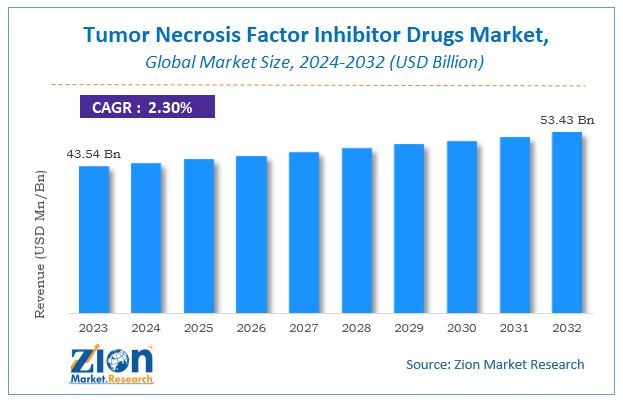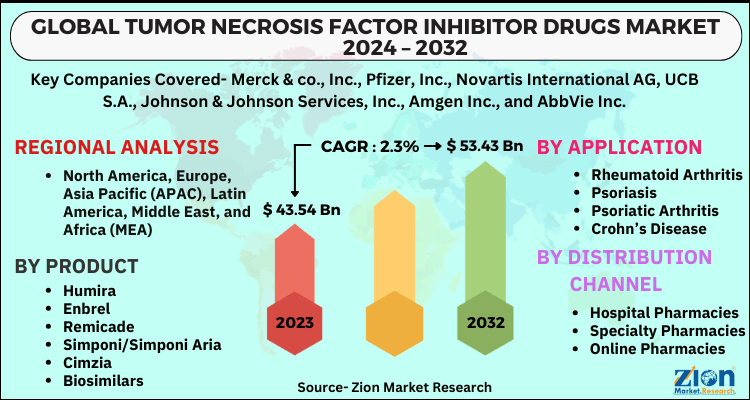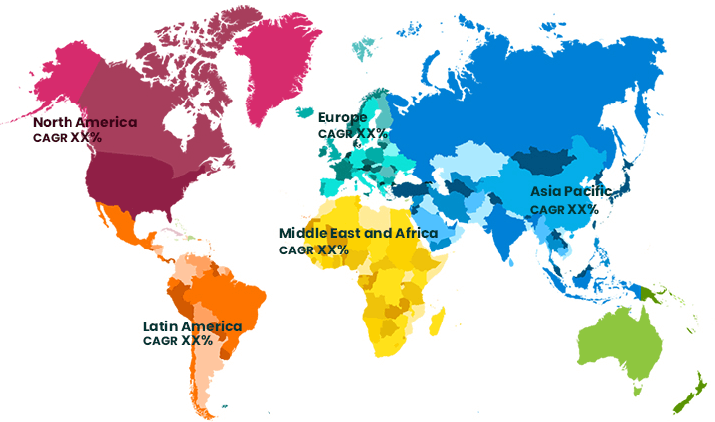Tumor Necrosis Factor Inhibitor Drugs Market Size, Share, And Growth Report 2032

Tumor Necrosis Factor Inhibitor Drugs Market by Product (Biosimilars, Cimzia, Simponi/Simponi Aria, Remicade, Enbrel and Humira), by Application (Psoriasis, Rheumatoid Arthritis, Psoriatic Arthritis, Ulcerative Colitis, Crohn’s Disease, Hidradenitis Suppurativa, Juvenile Idiopathic Arthritis, Ankylosing Spondylitis and Other Applications), By Distribution Channel (Specialty Pharmacies, Hospital Pharmacies and Online Pharmacies), and By Region - Global And Regional Industry Overview, market Intelligence, Comprehensive Analysis, Historical Data, And Forecasts 2024-2032-
| Market Size in 2023 | Market Forecast in 2032 | CAGR (in %) | Base Year |
|---|---|---|---|
| USD 43.54 Billion | USD 53.43 Billion | 2.3% | 2023 |
Tumor Necrosis Factor Inhibitor Drugs Market: Size
The global Tumor Necrosis Factor Inhibitor Drugs Market size was worth around USD 43.54 billion in 2023 and is predicted to grow to around USD 53.43 billion by 2032 with a compound annual growth rate (CAGR) of roughly 2.3% between 2024 and 2032.
The study provides historical data from 2018 to 2022 along with a forecast from 2024 to 2032 based on revenue (USD billion). The report covers a forecast and an analysis of the Tumor Necrosis Factor Inhibitor Drugs Market on a global and regional level.
Tumor Necrosis Factor Inhibitor Drugs Market: Overview
Tumor necrosis factor (TNF) is a multifunctional protein cytokine produced by immune cells that causes inflammation in the body and plays important role in various cellular functions such as cell proliferation, differentiation, survival, and death. Tumor necrosis factor inhibitors suppress the body’s innate response to tumor necrosis factor (TNF). These inhibitors are used in the treatment of inflammatory conditions such as psoriatic arthritis, ulcerative colitis, psoriasis, rheumatoid arthritis, ankylosing spondylitis, etc. These TNF inhibitor drugs are used in autoimmune disorders to avoid immune system attacks from healthy body cells.
The demand for the tumor necrosis factor inhibitor drugs market is driven by increasing autoimmune disorders across the globe, increasing geriatric population base, promising pipelines, new product launches, increasing awareness among patients, increasing healthcare expenditure, and increasing disposable income. However, the emergence of new biosimilars as a result of loss of patent exclusivity in different regions, the internal threats from biosimilars, and intense competition from interleukin inhibitors are major factors that may hinder the market growth. Growing consumer preference for cost-effective therapeutics with improved efficacy and safety will bring new growth opportunities for market players over the forecast period.
Tumor Necrosis Factor Inhibitor Drugs Market: Segmentation
Based on product, the global tumor necrosis factor inhibitor drugs market is bifurcated into Biosimilars, Cimzia, Simponi/Simponi Aria, Enbrel, Remicade, and Humira. The Humira product segment accounted for the largest market share in 2023 and is expected to retain its dominance over the forecast period. This is due to its patent exclusivity in the U.S. which will expire in 2023. The Biosimilar product segment will experience maximum growth over the forecast period as a result of patent expiry and new launches.
Based on applications market is segmented into psoriasis, rheumatoid arthritis, psoriatic arthritis, ulcerative colitis, Crohn’s disease, hidradenitis suppurativa, juvenile idiopathic arthritis, ankylosing spondylitis, and other applications. The rheumatoid arthritis application segment held dominating market share in 2023 driven by growing awareness, increasing incidence rate, and high treatment rate. Psoriatic arthritis and psoriasis application segments will witness the highest growth rate over the forecast period.
The distribution channel segment of the TNF inhibitor drugs market is divided into specialty pharmacies, hospital pharmacies and online pharmacies. The largest distribution channel in 2023 was hospital pharmacies. The online pharmacies distribution channel segment is projected to witness rapid growth in the coming years.
Tumor Necrosis Factor Inhibitor Drugs Market: Report Scope
| Report Attributes | Report Details |
|---|---|
| Report Name | Tumor Necrosis Factor Inhibitor Drugs Market |
| Market Size in 2023 | USD 43.54 Billion |
| Market Forecast in 2032 | USD 53.43 Billion |
| Growth Rate | CAGR of 2.3% |
| Number of Pages | 126 |
| Key Companies Covered | Merck & co., Inc., Pfizer, Inc., Novartis International AG, UCB S.A., Johnson & Johnson Services, Inc., Amgen Inc., and AbbVie Inc |
| Segments Covered | By Product Type, By Application, By Distribution Channel and By Region |
| Regions Covered | North America, Europe, Asia Pacific (APAC), Latin America, Middle East, and Africa (MEA) |
| Base Year | 2023 |
| Historical Year | 2018 to 2022 |
| Forecast Year | 2024 - 2032 |
| Customization Scope | Avail customized purchase options to meet your exact research needs. Request For Customization |
Tumor Necrosis Factor Inhibitor Drugs Market: Regional Analysis
North America dominated the global tumor necrosis factor inhibitor drugs market in 2023. Strong commercial sales, favorable reimbursement policies, the presence of key players, a large patient pool, and growing awareness are major factors driving the growth in this region. Europe was the second largest regional market in terms of revenue share. Availability of developed infrastructure, increasing cases of autoimmune disorders, and growing awareness are some of the factors that boost the market growth in this region.
Asia Pacific region will be the rapidly growing market for tumor necrosis factor inhibitor drugs. Healthcare infrastructure improvement, economic development, increasing geriatric population base, increasing disposable income and healthcare spending, and growing awareness are important factors attributing to the rapid growth in this region. On the other hand, Latin America will experience moderate growth in the coming years. The Middle East and Africa will register slower growth in the years to come.
Tumor Necrosis Factor Inhibitor Drugs Market: Competitive Analysis
Major players in the tumor necrosis factor inhibitor drugs market are:
- Merck & co. Inc.
- Pfizer Inc.
- Novartis International AG
- UCB S.A.
- Johnson & Johnson Services Inc.
- Amgen Inc.
- AbbVie Inc.
The report segment of global tumor necrosis factor inhibitor drugs market as follows:
Global Tumor Necrosis Factor Inhibitor Drugs Market: Product
- Humira
- Enbrel
- Remicade
- Simponi/Simponi Aria
- Cimzia
- Biosimilars
Global Tumor Necrosis Factor Inhibitor Drugs Market: By Application
- Rheumatoid Arthritis
- Psoriasis
- Psoriatic Arthritis
- Crohn’s Disease
- Ulcerative Colitis
- Ankylosing Spondylitis
- Juvenile Idiopathic Arthritis
- Hidradenitis Suppurativa
- Others
Global Tumor Necrosis Factor Inhibitor Drugs Market: By Distribution Channel
- Hospital Pharmacies
- Specialty Pharmacies
- Online Pharmacies
Global Tumor Necrosis Factor Inhibitor Drugs Market: By Region
- North America
- The U.S.
- Canada
- Europe
- France
- The UK
- Spain
- Germany
- Italy
- Rest of Europe
- Asia Pacific
- China
- Japan
- India
- South Korea
- Southeast Asia
- Rest of Asia Pacific
- Latin America
- Brazil
- Mexico
- Rest of Latin America
- Middle East & Africa
- GCC
- South Africa
- Rest of The Middle East & Africa
Table Of Content
Methodology
FrequentlyAsked Questions
Tumor necrosis factor (TNF) inhibitor drugs, also known as TNF blockers or TNF-alpha inhibitors, are a class of medications used to treat various inflammatory conditions. These drugs target a protein called tumor necrosis factor-alpha (TNF-alpha), which is a cytokine produced by the immune system. TNF-alpha plays a significant role in promoting inflammation and is involved in the pathogenesis of several autoimmune and inflammatory diseases.
As of my last knowledge update in September 2021, tumor necrosis factor (TNF) inhibitor drugs are a class of medications used to treat inflammatory conditions such as rheumatoid arthritis, psoriasis, Crohn's disease, and ankylosing spondylitis. The market for these drugs can be influenced by several key factors. Please note that developments might have occurred since then, so it's advisable to consult more recent sources for the latest insights.
According to study, the Tumor Necrosis Factor Inhibitor Drugs Market size was worth around USD 43.54 billion in 2023 and is predicted to grow to around USD 53.43 billion by 2032.
The CAGR value of Tumor Necrosis Factor Inhibitor Drugs Market is expected to be around 2.3% during 2024-2032.
Which region will contribute notably towards the tumor necrosis factor inhibitor drugs market value?
North America dominated the global tumor necrosis factor inhibitor drugs market in 2018. Strong commercial sales, favorable reimbursement policies, the presence of key players, a large patient pool, and growing awareness are major factors driving the growth in this region. Europe was the second largest regional market in terms of revenue share.
Major players in the tumor necrosis factor inhibitor drugs market are Merck & co., Inc., Pfizer, Inc., Novartis International AG, UCB S.A., Johnson & Johnson Services, Inc., Amgen Inc., and AbbVie Inc. among others.
RelatedNews
HappyClients
Zion Market Research
Tel: +1 (302) 444-0166
USA/Canada Toll Free No.+1 (855) 465-4651
3rd Floor,
Mrunal Paradise, Opp Maharaja Hotel,
Pimple Gurav, Pune 411061,
Maharashtra, India
Phone No +91 7768 006 007, +91 7768 006 008
US OFFICE NO +1 (302) 444-0166
US/CAN TOLL FREE +1 (855) 465-4651
Email: sales@zionmarketresearch.com
We have secured system to process your transaction.
Our support available to help you 24 hours a day, five days a week.
Monday - Friday: 9AM - 6PM
Saturday - Sunday: Closed








